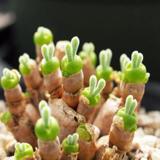
上传成功
举报
转发
2017年09月28日

一般来说选用的盆,要比多肉的冠幅(直径),大个1-2cm,或1/3-1/4,更利于多肉长大,或群生。盆的高度可比盆宽度略高,或略矮(瓦苇系的盆可高点),通常不建议细筒高盆,不利于空气流通,也不利于把握浇水的分量。
#多肉 种下后,盆留有一定间隙,方便多肉生长,也方便自己浇水。
[图片][图片][图片][图片][图片][图片]如果植株本身是生长较快的品种,如仙女之舞、玉蝶,选择的盆可以再大点,如植株的2-3倍宽,盆太大,浇水的时机会较难把握。不清楚长得快不快,则参考上一点,可以等长大了,再换盆。
盆过大的情况下,浇水要多用点心。
[图片][图片]如果,不想多肉长太大,保持多肉娇小的体型,则可以用跟多肉大小差不多,或比多肉还小的盆,以达到控型的目的。
已经半木质化的老桩也没必要换更大的盆,已经长不动了。
[图片][图片]
...显示更多
文章
举报
转发
2017年09月28日

[图片]#雏菊 能是否适合水培
估计问出这个问题的网友们也是因为买来的鲜切花觉得丢弃太可惜了,所以想着看看能否在花瓶里进行水培,让雏菊存活下来,小编可以告诉大家这不是一件只要按步骤操作了就能成功的事情,因为雏菊是一种土壤栽培的花卉,水培对它来说并不是一种合适的栽培方法,不过大家可以试一下。
[图片]雏菊水培的方法
如果大家手头上有新鲜的雏菊花束就需要先进性一下消毒处理,因为无论是任何植物想要在水中栽培都要进行这个操作,这是防止细菌滋生的最佳做法。其次要将准备好的花瓶灌上水,不要太满,大概在70%左右即可,然后将收拾好的雏菊枝条放进去,滴上适量的水培夜,然后放置在一个比较阴凉但不晦暗的室内环境,要注意通风效果良好。水培最关键的就是水分的干净,长时间不换水会导致枝茎底部腐烂,滋生细菌影响植株健康,所以大家还要注意及时换水。
一般的情况下雏菊在水中栽培能够存活两到三周的时间,如果超过三周还没有丝毫要萌发新根的迹象,基本上就能判定水培失败了,所以小编不能明确的告诉大家是否可以水培,只能建议大家自行去尝试一番,或许你就可以成功。
[图片]
...显示更多
文章
举报
转发
2017年09月28日

[图片]育苗
选取#香瓜 种子以后,先把它晒两天。然后再用55度的温水一遍倒水一遍搅拌后泡上5到8个小时即可。将种子取出洗净以后再用湿的棉毛巾包好套一个塑料袋,放到30到32度的环境中,一般18到20个小时后芽就能出来了。等到长出了四片叶子的时候就能定植了 。
[图片]管理
在植物的苗期,除了花打顶以外等枝杈长到3到5cm时再将杈打掉,最好是在天气比较好的上午,不能用剪刀或是手掐。浇水的话要在长出2片叶子再浇,第一次的时候不需要施肥。等到第一茬瓜鸡蛋大时再用膨瓜肥。一般10到15天浇一次水就可以了。
施肥
幼苗期的时候,一般施氮磷含量都比较多的。茎叶生长较快的时期主要用氮肥。结瓜的时候主要施用钾氮肥。
授粉
如果需要手动授粉就要在上午进行,建议在9到10点之间,应该在雌花开后的两小时授粉。
采收
等到香瓜成熟了之后就可以采收了,具体方法是用手指按靠近果脐的那一面,发软就是熟了,或者是闻一下有么有香瓜所独有的浓香,如果熟了的话就用剪刀剪下来。
[图片]
...显示更多
文章
滚动加载更多...
article








